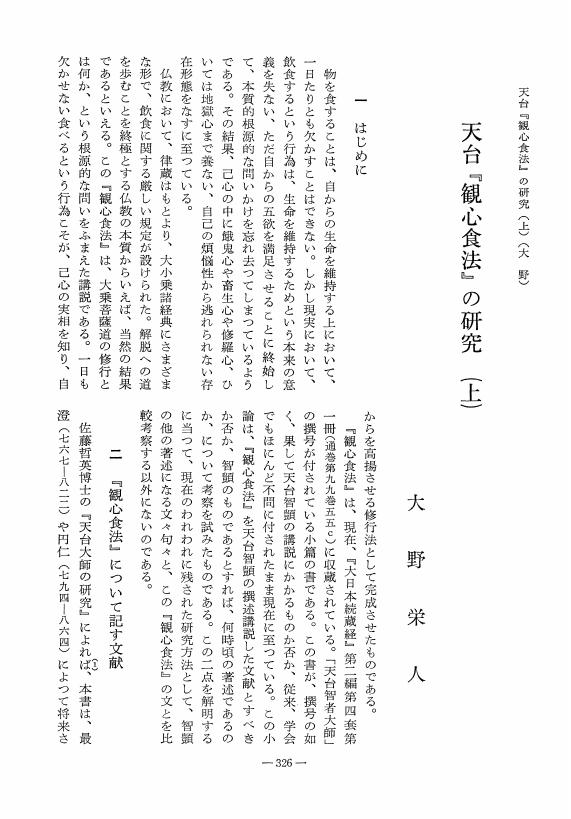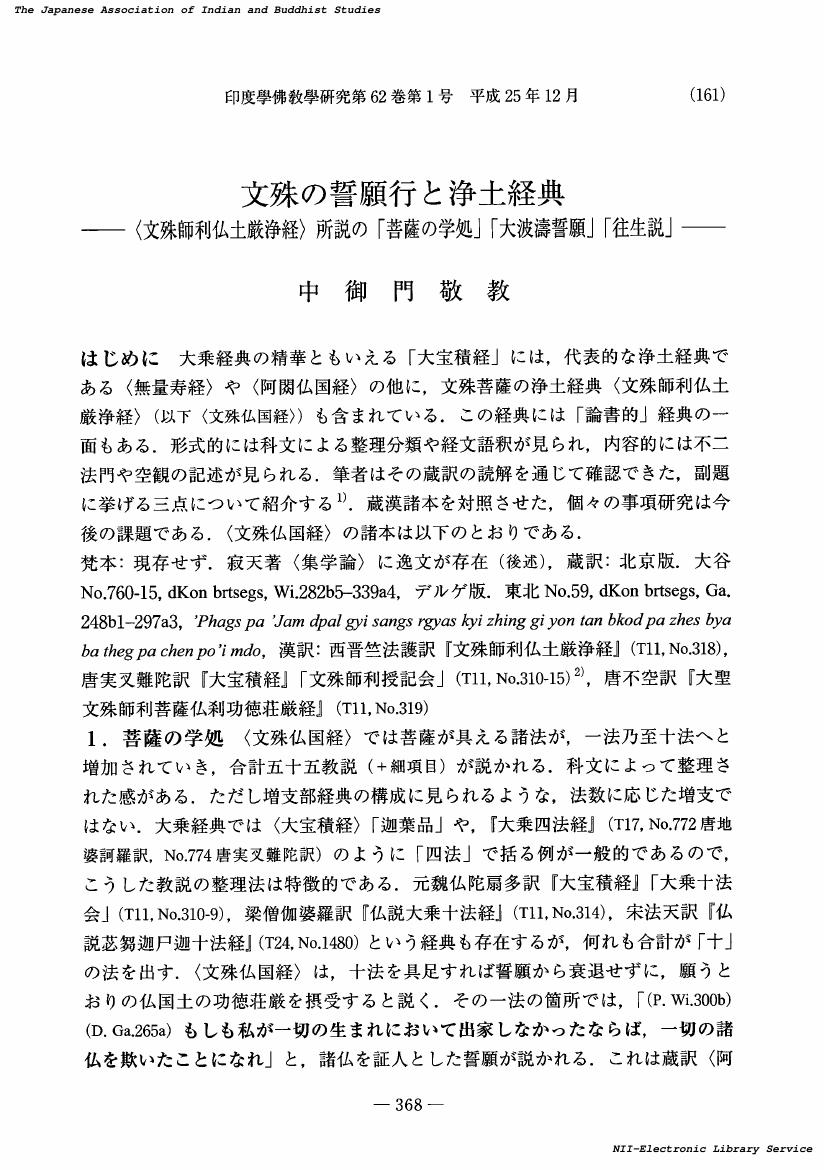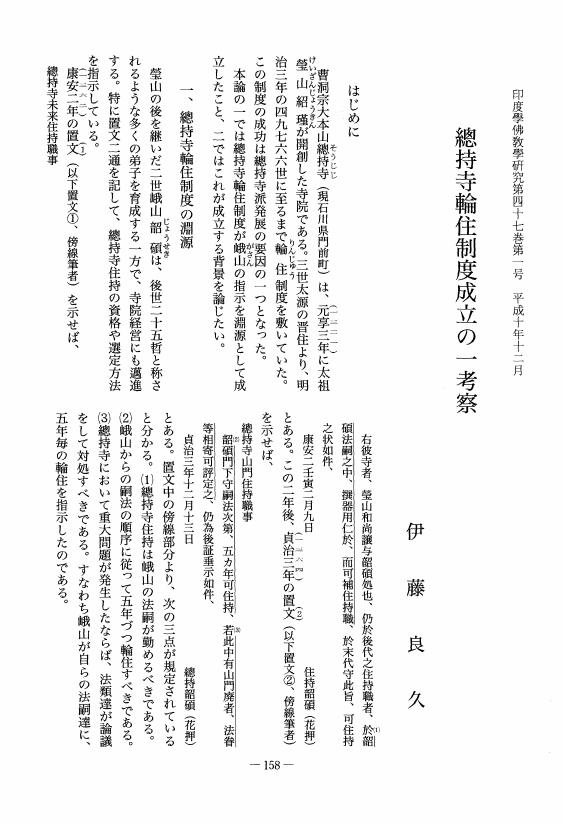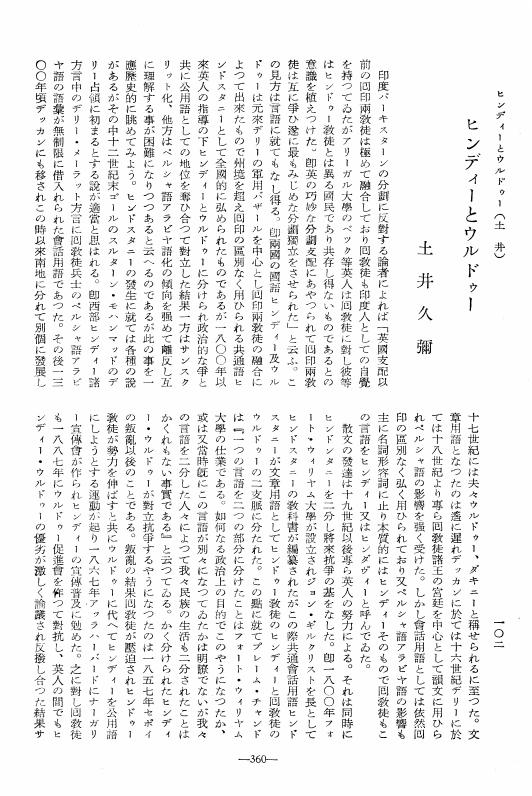1 0 0 0 OA 天台『観心食法』の研究 (上)
- 著者
- 大野 栄人
- 出版者
- Japanese Association of Indian and Buddhist Studies
- 雑誌
- 印度學佛教學研究 (ISSN:00194344)
- 巻号頁・発行日
- vol.29, no.1, pp.326-331, 1980-12-31 (Released:2010-03-09)
- 著者
- 中御門 敬教
- 出版者
- 日本印度学仏教学会
- 雑誌
- 印度學佛教學研究 (ISSN:00194344)
- 巻号頁・発行日
- vol.62, no.1, pp.368-363, 2013-12-20 (Released:2017-09-01)
1 0 0 0 OA 捨身と生命倫理
- 著者
- 岡田 真美子
- 出版者
- Japanese Association of Indian and Buddhist Studies
- 雑誌
- 印度學佛教學研究 (ISSN:00194344)
- 巻号頁・発行日
- vol.48, no.2, pp.1000-995, 2000-03-20 (Released:2010-03-09)
1 0 0 0 OA 真宗における神祇不拝の教学史的変遷
- 著者
- 野世 英水
- 出版者
- Japanese Association of Indian and Buddhist Studies
- 雑誌
- 印度學佛教學研究 (ISSN:00194344)
- 巻号頁・発行日
- vol.39, no.1, pp.203-206, 1990-12-20 (Released:2010-03-09)
1 0 0 0 OA 總持寺輪住制度成立の一考察
- 著者
- 伊藤 良久
- 出版者
- Japanese Association of Indian and Buddhist Studies
- 雑誌
- 印度學佛教學研究 (ISSN:00194344)
- 巻号頁・発行日
- vol.47, no.1, pp.158-160, 1998-12-20 (Released:2010-03-09)
1 0 0 0 OA 中論における無自性と無 -青目釋「空亦復空」について-
- 著者
- 八力 廣喜
- 出版者
- Japanese Association of Indian and Buddhist Studies
- 雑誌
- 印度學佛教學研究 (ISSN:00194344)
- 巻号頁・発行日
- vol.17, no.2, pp.718-723, 1969-03-31 (Released:2010-03-09)
1 0 0 0 OA 中国唯識における聞熏習説について
- 著者
- 吉村 誠
- 出版者
- 日本印度学仏教学会
- 雑誌
- 印度學佛教學研究 (ISSN:00194344)
- 巻号頁・発行日
- vol.58, no.1, pp.246-251, 2009-12-20 (Released:2017-09-01)
1 0 0 0 OA 中国南北朝期における止観
- 著者
- 山口 弘江
- 出版者
- 日本印度学仏教学会
- 雑誌
- 印度學佛教學研究 (ISSN:00194344)
- 巻号頁・発行日
- vol.68, no.2, pp.804-810, 2020-03-20 (Released:2020-09-10)
- 参考文献数
- 19
The most famous practice of meditative cessation and observation in East Asia was the Tiantai system called zhiguan 止観, established by Tiantai Zhiyi 天台智顗 (538–597). Moreover, the type of zhiguan taught in the section on the aspect of practice and the attitude of faith within the Dasheng qi xin lun 大乗起信論 (Awakening of Mahāyāna Faith), which in recently years has been shown to have been produced in northern China, was important since it greatly influenced the later Buddhist world. It is thought that the reception and proliferation of zhiguan in the Northern and Southern Dynasties period occurred with the background of this meditative practice.Zhiguan is generally regarded as a translation of śamatha and vipaśyanā, but the source terms were not limited to these. In addition to examples that correspond to sthāna and upalakṣaṇā (listed among the the six breath meditations or liu xinian 六息念), similarly the parts translated as zhiguan in the Chinese translations of the Vimalakīrtinirdeśa by Zhi Qian, Kumārajīva and Xuanzang are all identified as śamatha-vidarśanā in the corresponding Sanskrit text. Having rendered zhiguan from different source words, awareness of the differences in the original vocabulary were lost in the interpretations by Chinese monks. We can consider this one reason underlying the development of the unique system of zhiguan in East Asia.
1 0 0 0 OA 廬山の禅宗
- 著者
- 鈴木 哲雄
- 出版者
- Japanese Association of Indian and Buddhist Studies
- 雑誌
- 印度學佛教學研究 (ISSN:00194344)
- 巻号頁・発行日
- vol.27, no.1, pp.276-279, 1978-12-31 (Released:2010-03-09)
1 0 0 0 OA 大弐房宥範の教学
- 著者
- 林山 まゆり
- 出版者
- 日本印度学仏教学会
- 雑誌
- 印度學佛教學研究 (ISSN:00194344)
- 巻号頁・発行日
- vol.65, no.1, pp.34-39, 2016-12-20 (Released:2017-10-17)
- 参考文献数
- 7
Yūhan 宥範 (1270–1352), a Buddhist priest famous for the regeneration of Zentsūji 善通寺 in the province of Sanuki (today’s Kagawa prefecture), was also a learned scholar who wrote the Dainichikyō sho myōinshō 大日経疏妙印鈔, Ayūshō 阿宥鈔, and so forth. His books concern Buddhist teachings.Yūhan’s understanding of Buddhism has been referred to in the history of esoteric teaching. However, all such references are nothing but a partial introduction of his teaching; very few studies have been conducted from the integrated viewpoint, or have focused on his later influence. Hence, in this paper, through the estimations of Yūhan by later scholars, his position in the history of the esoteric teaching is examined.As a result, it is clarified that the reason why Yūhan is bitterly criticized by Yūkai 宥快 (1345–1416), who is thought to have established the Kōyasan Teaching, and by Myōzui 妙瑞 (1696–1764), a priest of the Kōyasan in the Edo period, is that his understanding often criticizes traditional understandings. It is also concluded that the reason why In’yū 印融 (1435–1519), a Shingon priest from the Kantō area, accepts Yūhan’s books is that In’yū examines the validity of old Kōyasan teachings relying on Izu 伊豆 understandings which flourished in the Kantō region.
1 0 0 0 OA 近世京都書肆柳枝軒小川多左衛門について
- 著者
- 中野 何必
- 出版者
- 日本印度学仏教学会
- 雑誌
- 印度學佛教學研究 (ISSN:00194344)
- 巻号頁・発行日
- vol.67, no.2, pp.575-578, 2019-03-20 (Released:2019-09-20)
- 参考文献数
- 7
Regarding Ryūshiken Ogawa Tazaemon, a publisher of early modern Kyōto, his descendant Ogawa Saburō reported in detail in recent years. So far, this report is the most detailed concerning Ryūshiken. However, it does not deal with Buddhist publications.I am currently researching Ryūshiken as a purveyor to the Sōtō sect. So far, I have researched the publications of Ryūshiken in Komazawa University Library. In this paper, I report in detail on Ryūshiken, with the results of my survey.
1 0 0 0 OA 『不空羂索神変真言経』の梵本について
- 著者
- 高橋 尚夫
- 出版者
- Japanese Association of Indian and Buddhist Studies
- 雑誌
- 印度學佛教學研究 (ISSN:00194344)
- 巻号頁・発行日
- vol.40, no.2, pp.891-888, 1992-03-20 (Released:2010-03-09)
1 0 0 0 OA 江戸法詔寺の興廃をめぐって ――敬台院万姫と法華信仰――
- 著者
- 長倉 信祐
- 出版者
- 日本印度学仏教学会
- 雑誌
- 印度學佛教學研究 (ISSN:00194344)
- 巻号頁・発行日
- vol.62, no.1, pp.205-208, 2013-12-20 (Released:2017-09-01)
1 0 0 0 OA 『却温黄神呪経』と摩怛利神信仰
- 著者
- 赤塚 祐道
- 出版者
- 日本印度学仏教学会
- 雑誌
- 印度學佛教學研究 (ISSN:00194344)
- 巻号頁・発行日
- vol.70, no.1, pp.189-194, 2021-12-20 (Released:2022-09-09)
- 参考文献数
- 4
The sūtra named Que wenhuang shenzhou jing却温黄神呪経 contains a method for curing epidemics accompanied by high fever. This method was to recite the names of seven kijin鬼神 demons to eliminate the invisible epidemic. In later times it was believed that enshrining the seven kijin demons or Matari-jin摩怛利神 and reading this text would prevent epidemics. The names of Matari-jinja摩怛利神社 or Shichiki-jinja七鬼神社 shrines remain to the present day.This paper discusses how the demons in the sūtra are connected to faith in Matari-jin as it developed from the Que wenhuang shenzhou jing. As mentioned above, seven demons are taught in the Que wenhuang shenzhou jing. The Shichi-Kijin七鬼神 painting in the Kyoto City University of Arts is one example of faith in Matari-jin, and can be traced back to the Shichimonyo-ten maṇḍala七母女天曼荼羅 taught in the thirteenth chapter of the Liqu jing理趣経. That is to say, the Shichi-Kijin painting and the Shichimonyo-ten maṇḍala both have Makakyara-ten摩訶迦羅天 as their central deity, with the seven kijin demons painted around him. This Makakyara-ten is Mahākāla, who manifests as Matari-jin, the god of epidemics.The Que wenhuang shenzhou jing and esoteric Buddhist practice are deeply involved in the background to this faith in Matari-jin, and this sūtra was read and Matari-jin was worshipped to dispel epidemics.
1 0 0 0 OA 竜樹の根本錯視としてのテーゼ「空性とは縁起のことである」
- 著者
- 津田 眞一
- 出版者
- Japanese Association of Indian and Buddhist Studies
- 雑誌
- 印度學佛教學研究 (ISSN:00194344)
- 巻号頁・発行日
- vol.50, no.1, pp.385-379, 2001-12-20 (Released:2010-03-09)
1 0 0 0 OA インドにおけるペルシア文学
- 著者
- 黒柳 恒男
- 出版者
- Japanese Association of Indian and Buddhist Studies
- 雑誌
- 印度學佛教學研究 (ISSN:00194344)
- 巻号頁・発行日
- vol.19, no.1, pp.108-111, 1970-12-25 (Released:2010-03-09)
1 0 0 0 OA ヒンディーとウルドゥー
- 著者
- 土井 久彌
- 出版者
- Japanese Association of Indian and Buddhist Studies
- 雑誌
- 印度學佛教學研究 (ISSN:00194344)
- 巻号頁・発行日
- vol.1, no.2, pp.360-361, 1953-03-25 (Released:2010-03-12)
1 0 0 0 OA 「初期無量寿経」の原典は何か?――菩薩思想と往生思想を中心に――
- 著者
- 肖 越
- 出版者
- 日本印度学仏教学会
- 雑誌
- 印度學佛教學研究 (ISSN:00194344)
- 巻号頁・発行日
- vol.70, no.2, pp.887-883, 2022-03-23 (Released:2022-09-09)
- 参考文献数
- 19
This paper explores the original forms of the two earliest versions of the Larger Sukhāvatīvyūha sūtra, the Da Amituo jing 大阿彌陀經 (T. 362) and the Wuliang qingjing pingdengjue jing 無量清淨平等覺經 (T. 361). The issues have been approached from the following perspectives:First, I clarify the concept of the Early Recension of the Larger Sukhāvatīvyūha sūtra based on a suggestion by Fujita Kotatsu.Second, I determine the original form of the second-earliest version of the Larger Sukhāvatīvyūha sūtra, the Wuliang qingjing pingdengjue jing, and indicate that the original form of this version should be paralleled with the extant Sanskrit version, whose earliest manuscript was recognized as written in the middle of the twelfth century.Third, I discuss the most significant characteristics of the Da Amituo jing, bodhisattva thought and rebirth. Moreover, I discuss the 129 characters found in the Dharmākara narrative associated with their counterparts in two verses, called in Japanese Tanbutsu-ge and Tōhō-ge, in the extant Sanskrit version. Furthermore, I discuss the six vows in the Da Amituo jing from the perspective of bodhisattva thought along with the concept of rebirth purposely highlighted in these vows.Finally, I determine the formation of the 24th vow and its fulfillment regarding birth by praising the light of Amitābha and the texts regarding visualizing the Buddha by chanting his name as found in the latter of the Da Amituo jing.In conclusion, I indicate that the original forms of the Da Amituo jing and the Wuliang qingjing pingdengjue jing were quite probably similar, and separately, quite parallel with the extant Sanskrit version.
1 0 0 0 OA 『摩訶止観』と精神分析
- 著者
- 三輪 是法
- 出版者
- 日本印度学仏教学会
- 雑誌
- 印度學佛教學研究 (ISSN:00194344)
- 巻号頁・発行日
- vol.70, no.3, pp.1244-1250, 2022-03-25 (Released:2022-09-09)
- 参考文献数
- 3
天台大師智顗(538-597)が『摩訶止観』で説く「一念三千」は,不可思議なる対象として人間の心を表した言葉で,三千という数字は法華経の十如是と地獄界から仏界までの十界,そして五蘊世間・衆生世間・国土世間の三種世間の乗数によって導かれている.『摩訶止観』巻五上では,止観という修行による対境として最初に陰入界境を説明する.陰入界は実体をもたない人間存在を表し,まず迷いの原因である識陰の心を観察する必要があるという.その観察法として十種の方法をあげ,その第一番目が観不思議境である.五陰,十法界,十如是,三種世間の関係を詳述した後,心の様相として「一念三千」が説かれる.すなわち,我々の心は十種の人格的要因(十界)と現象の構成要素(十如是),さらに環境的外部要因を含めた関係性(三種世間)によって成り立っているということで,換言すると,心は他者によって形成されているといえるであろう. そこで現代における心の研究分野である精神分析の理論に基づいて考察すると,そもそも精神分析は,正常な人間は存在しないという立場に立っており,悩める主体である「分析主体」自身が自らの問題を主体的に解決していく営みであるということを知る.精神分析では,自我という自己像は他者との関係を通して作りあげられた虚構であり,また,主体というものは存在せず,意識と無意識との関係性において,一瞬,無意識の主体が出現するとしている.すなわち,『摩訶止観』で観察対象となる陰入界が他者によって形成された自我であり,観察結果として得られる一念三千という心が無意識の主体であると考えられる.換言すると,悩める分析主体が一念三千という境地に至ることによって,生き方を自ら選択できる可能性が生まれるということであり,ここに仏教と精神分析との類似性が確認できる.
1 0 0 0 OA 仏法と王法 -親鸞の君王加観-
- 著者
- 池田 勇諦
- 出版者
- Japanese Association of Indian and Buddhist Studies
- 雑誌
- 印度學佛教學研究 (ISSN:00194344)
- 巻号頁・発行日
- vol.25, no.2, pp.814-817, 1977-03-31 (Released:2010-03-09)













